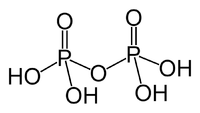Pyrophosphoric acid
 | |
 | |
| Names | |
|---|---|
| IUPAC names
Diphosphoric acid μ-oxido-bis(dihydroxidooxidophosphorus) | |
| Other names
Diphosphoric acid | |
| Identifiers | |
| 2466-09-3 | |
| ChEBI | CHEBI:29888 |
| ChEMBL | ChEMBL1160571 |
| ChemSpider | 996 |
| 3151 | |
| Jmol interactive 3D | Image |
| PubChem | 1023 |
| UNII | 4E862E7GRQ |
| |
| |
| Properties | |
| H4P2O7 | |
| Molar mass | 177.98 g/mol |
| Melting point | 71.5 °C (160.7 °F; 344.6 K) |
| Extremely soluble | |
| Solubility | Very soluble in alcohol, ether |
| Except where otherwise noted, data are given for materials in their standard state (at 25 °C [77 °F], 100 kPa). | |
| | |
| Infobox references | |
Pyrophosphoric acid, also known under the name diphosphoric acid, is colorless, odorless, hygroscopic and is soluble in water, diethyl ether, and ethyl alcohol. The anhydrous acid has two different forms, which melt at 54.3°C and 71.5°C. It is best prepared by ion exchange from sodium pyrophosphate or by reacting hydrogen sulfide with lead pyrophosphate. When phosphoric acid is dehydrated pyrophosphoric acid is produced as one of the products. When molten pyrophosphoric acid rapidly forms an equilibrium mixture of phosphoric acid, pyrophosphoric acid and polyphosphoric acids. The percentage by weight of pyrophosphoric acid is around 40% and it is difficult to recrystallise from the melt. In aqueous solution pyrophosphoric acid like all polyphosphoric acids hydrolyses and eventually an equilibrium is established between phosphoric acid pyrophosphoric acid and polyphosphoric acids. When highly diluted an aqueous solution of pyrophosphoric acid contains only phosphoric acid.[1]
- H4P2O7 + H2O
 2H3PO4
2H3PO4
Pyrophosphoric acid is a medium strong inorganic acid. Anions, salts, and esters of pyrophosphoric acid are called pyrophosphates.
While pyrophosporic acid is corrosive, it is not known to be otherwise toxic.[2]
History
The name pyrophosphoric acid was given by a "Mr. Clarke of Glasgow" in 1827 who is credited with its discovery following the heating to red heat of a sodium phosphate salt. It was found that phosphoric acid when heated to red heat formed pyrophosphoric acid that was readily converted to phosphoric acid by hot water.[3]
See also
- Sodium pyrophosphate
- Calcium pyrophosphate dihydrate deposition disease
- Dimethylallyl pyrophosphate
- ADP
- ATP
- Ortho acids
- triphosphoric acid
References
- ↑ Corbridge, D. (1995). "Chapter 3: Phosphates". Studies in inorganic Chemistry vol. 20. Elsevier Science B.V. pp. 169–305. ISBN 0-444-89307-5. Retrieved January 30, 2015. – via ScienceDirect (Subscription may be required or content may be available in libraries.)
- ↑ Material Safety Data Sheet: Pyrophosphoric acid MSDS www,sciencelab.com
- ↑ Beck, Lewis Caleb (1834). A Manual of Chemistry: Containing a Condensed View of the Present State of the Science, with Copious References to More Extensive Treatises, Original Papers, Etc. E.W & C Skinner. p. 160. Retrieved January 30, 2015.